- Quick Read
- Deep Read ( 5 Min. )

Why is Christian Science in our name?
Our name is about honesty. The Monitor is owned by The Christian Science Church, and we’ve always been transparent about that.
The Church publishes the Monitor because it sees good journalism as vital to progress in the world. Since 1908, we’ve aimed “to injure no man, but to bless all mankind,” as our founder, Mary Baker Eddy, put it.
Here, you’ll find award-winning journalism not driven by commercial influences – a news organization that takes seriously its mission to uplift the world by seeking solutions and finding reasons for credible hope.
Explore values journalism About usMonitor Daily Podcast
- Follow us:
- Apple Podcasts
- Spotify
- RSS Feed
- Download
TODAY’S INTRO
Monitor Daily Intro for September 20, 2017
 Yvonne Zipp
Yvonne Zipp
Is there a right way to get a pet?
Our dog (a beagle, basset, Jack Russell mix) jumped in my lap at an adoption event. One cat was a tiny blue-eyed ball of fluff and fleas my husband found at the county shelter. The other was a stray that loitered hopefully outside our house.
We tend not to buy animals. That’s our family’s choice.
California’s Assembly has passed a law that would make it the first state in the nation to outlaw the sale of puppies, kittens, and rabbits in pet stores unless they come from shelters or rescue organizations. More than 230 US cities and counties have passed similar measures.
Animal welfare advocates say the law will protect pets from unsanitary and inhumane conditions. Pet stores and commercial breeders say the bill paints with an unfairly broad brush and will put them out of business. They have urged Gov. Jerry Brown to veto it.
Whatever the outcome, the bill's passage reflects a continuing shift in American society from regarding animals as commodities to feeling beings – and sometimes, as shown in viral photos of Houstonians carrying dogs through thigh-high floodwaters, beloved family members. Those who left their pets caged or tied up – sparking national outrage – show that shift is still in progress.
But the progress is there: While the American Society for the Prevention of Cruelty to Animals estimates that 1.5 million shelter animals are euthanized each year, the number has declined from approximately 2.6 million in 2011. And adoptions are up.
Now to our five stories for your Wednesday.

Help fund Monitor journalism for $11/ month
Already a subscriber? Login

Monitor journalism changes lives because we open that too-small box that most people think they live in. We believe news can and should expand a sense of identity and possibility beyond narrow conventional expectations.
Our work isn't possible without your support.
Mexico’s quake reveals better prep, grass-roots responsiveness
In Mexico, as in Texas, Florida, and the Caribbean before it, the immediate response to natural disaster has been neighbor rushing to help neighbor – an instinct rooted in both a spirit of generosity and the memory of past catastrophes.
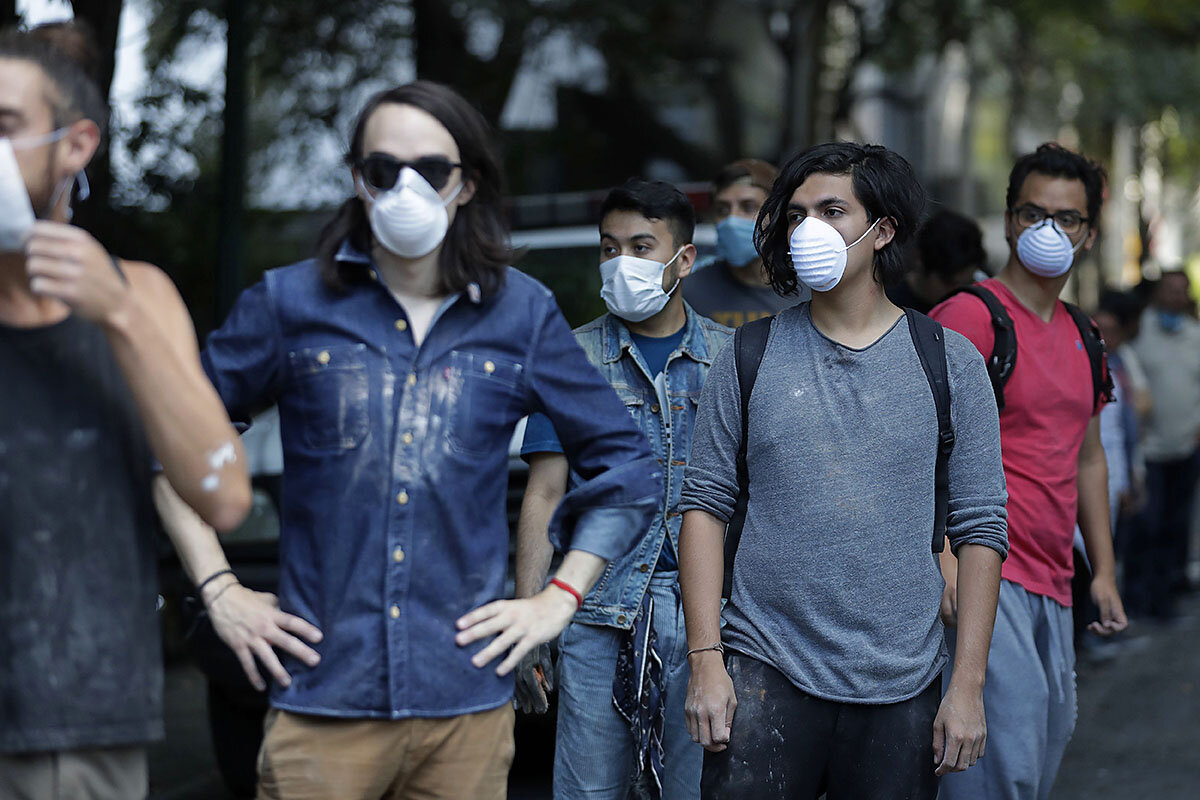
In Mexico City, Tuesday, Sept. 19, was the 32nd anniversary of a devastating earthquake. Office buildings and schools participated in drills, a citywide alert system sounded through the streets, and government officials attended commemorations of the event that still haunts this megacity. Roughly two hours later, some alarms went off again, but this time it was not a drill. A magnitude-7.1 earthquake in nearby Puebla State rocked Mexico City, killing more than 220 people nationwide – Mexico’s second big quake in two weeks. But the moment the ground stopped trembling, residents jumped into action: a reaction, in part, to memories of officials’ disorganized response three decades before. When a government worker arrived at the scene of one collapsed building, he was instantly bombarded by requests from volunteers. Crowds had gathered on a nearby park plaza to organize donations of water, cleaning supplies, trash bags, bread, and blankets, while others cleared rubble throughout the city. “This is Mexico,” says one young man, who wasn’t alive for the ’85 quake but rushed to help this week. “We are neighbors. We believe in solidarity.”
Mexico’s quake reveals better prep, grass-roots responsiveness
Baruch García stood at an intersection Tuesday afternoon after a deadly earthquake, trying to direct traffic away from a road cutting through La Condesa’s lush Parque México. On the other side of the park, hundreds of volunteers – from a young boy in a yellow soccer uniform, to a woman in slacks and ballet flats, and a man wearing an apron from a nearby café – lined the street for blocks, helping to remove rubble from an eight-story collapsed building with an unknown number of people buried inside.
Tuesday afternoon, a 7.1 earthquake in nearby Puebla State rocked Mexico City, some 75 miles away. It toppled homes, schools, and other structures, trapping citizens and killing at least 86 in the capital and a total of 217 nationwide, according to the Mexican Civil Defense Agency. The death toll is expected to rise. Mr. García was in the park walking his dogs when the quake hit.
“The first thing I thought when it was over was, ‘I have to help,’ ” he says. Someone called out that a building had fallen on the other side of the park – they needed traffic to stop. So, he pulled his car around to the intersection and blocked it, along with one other person’s car. They posted small hand-written signs that read, “No hay paso,” only moving one of the vehicles when soldiers, ambulances, or other officials needed through.
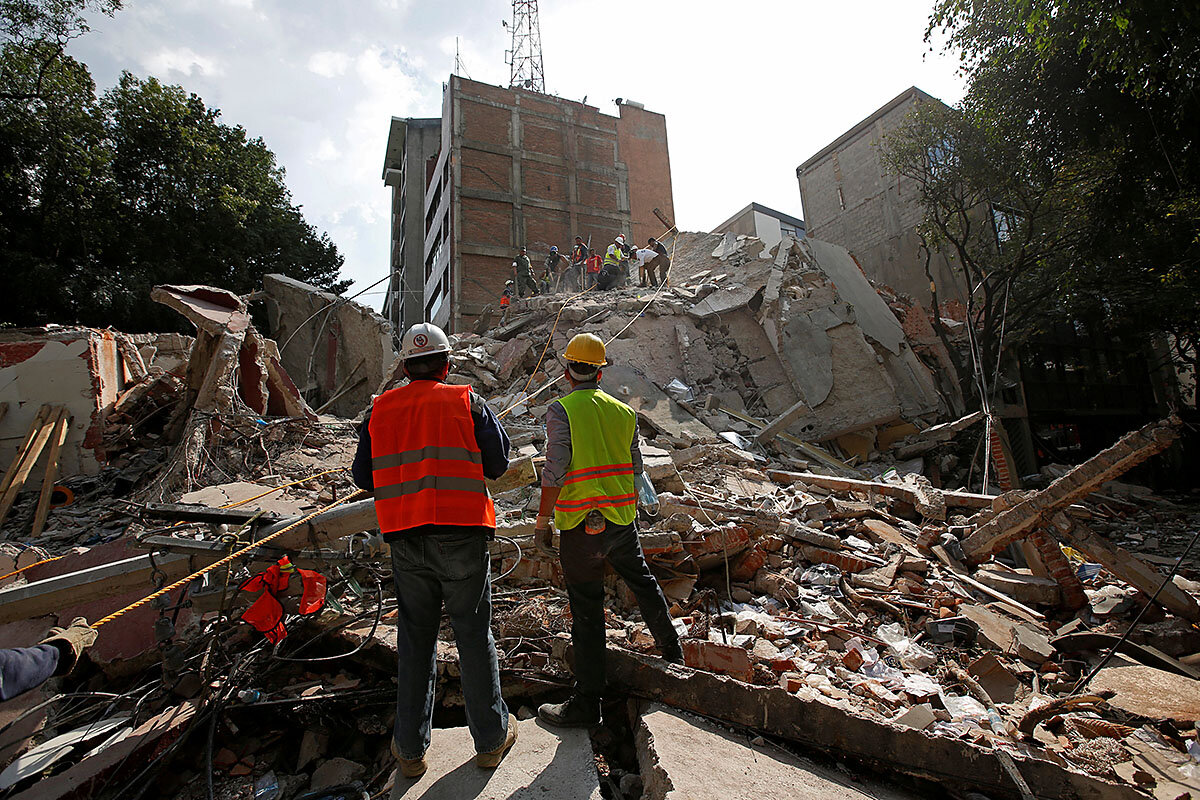
García wasn’t the only one moved to help. The moment the ground stopped trembling, Mexico City residents jumped into action, directing traffic after street lights went out, offering the use of bathrooms or telephones, setting up collection sites for food, water, flashlights, and blankets, and using their bare hands or tools at their disposal to remove rubble in hopes of rescuing residents trapped in buildings. At least one engineering firm announced free home inspections and ride-share companies were temporarily offering free transport.
The response is in part a legacy of Mexico’s haunting 1985 earthquake, which left an estimated 10,000 people dead and another 30,000 wounded. The government’s reaction at the time was disorganized and inept, and as a result, citizens took search, rescue, and post-quake support into their own hands, creating grassroots civilian response teams.
Yesterday’s temblor fell on the 32nd anniversary of the 1985 quake. Just hours before the ground began to violently shake, office buildings and schools across the city participated in an earthquake drill, a citywide alert system sounded through the streets, and government officials attended commemorations of the event that still haunts this megacity.
Roughly two hours later, some alarms went off again, but this time it was not a drill.
The city’s earthquake alarms, coupled with stronger building codes and official action plans, are a testament to improvements in government preparedness and response since 1985. However, in the immediate aftermath it was clear that citizens were well-versed in responding to disasters.
“We don’t have a lot of faith in our institutions, so we’ve learned to jump in and help instead of waiting,” says José Cruz, a lawyer organizing water donations in an amphitheater inside Parque México.
Volunteers, many communicating via social media, gathered on the concrete plaza to organize donations of water, cleaning supplies, trash bags, bread, and blankets and direct them to nearby sites in need. Gabriel Carillo, a life coach, held up a poster that read “We need flashlights in the Parque México esplanade,” and asked passersby to take a photo and post it on social media.
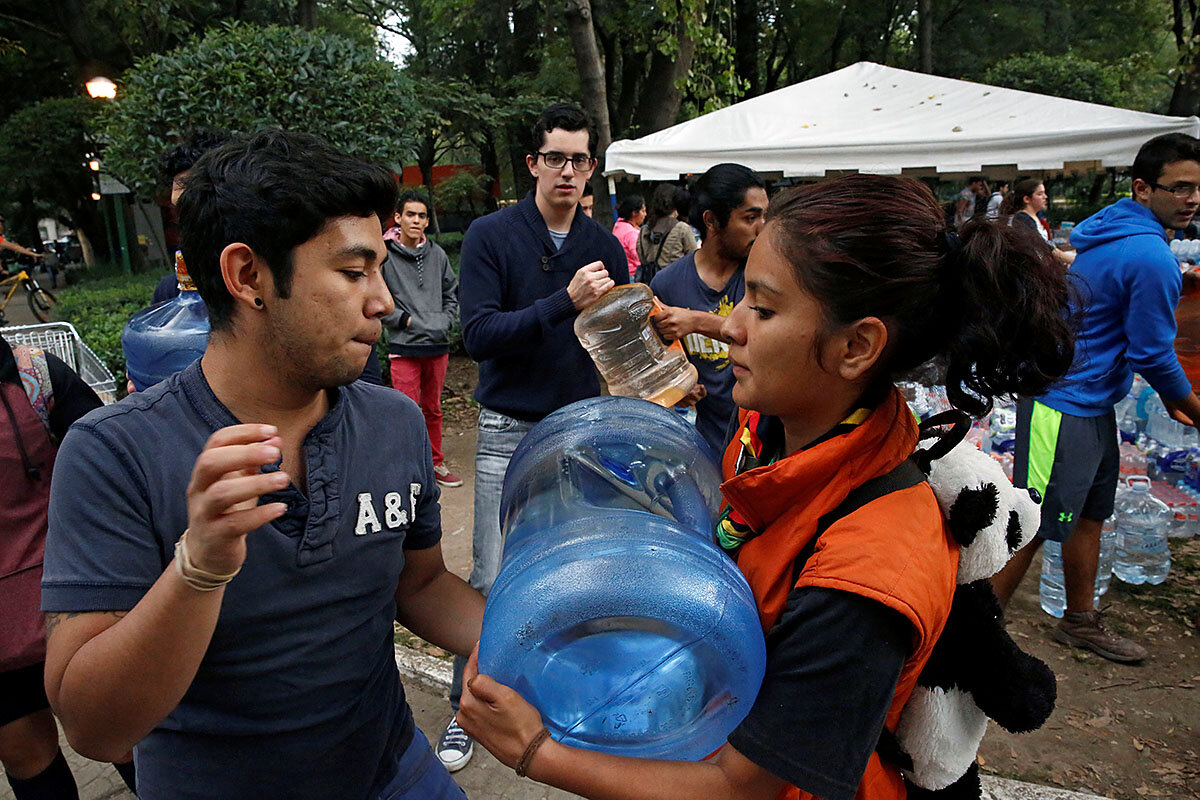
“This is Mexico,” says Alejandro Lira, who wasn’t alive for the ’85 quake but rushed to help gather supplies for victims this week. “We are neighbors, we believe in solidarity.”
An employee of the Cuahtémoc borough, where Condesa is located, walked onto the plaza and was instantly bombarded with requests from volunteers.
“We need a generator,” José Luis Jimenez, a leader of Scout troop #24, called out. Six members of his troop were there helping organize and deliver donations. “People from the neighborhood are coming here to spend the night. We need to provide security, emotional support. In a few hours, everything will be black,” he says. The neighborhood was overwhelmed with families pulling rolling suitcases and carrying pet crates. They wouldn’t go home to sleep, either because they were told their building wasn’t safe, or they decided it themselves.
Alain Sanchez, the Cuahtémoc borough worker, said he was impressed by the civilian response. “A building fell and by the time we got there, there were already crowds of people helping. We’ve seen incredible support from civil society,” he says.
Mexico is prone to earthquakes, but Mexico City itself is not on a fault line. Instead, its location upon a former lake bed means it’s vulnerable to temblors hundreds of miles away. This is Mexico’s second big quake in just as many weeks. More than 90 people in the southern states of Chiapas and Oaxaca died in an 8.1 quake on Sept. 7, the country’s most powerful in decades.

US Geological Survey
Mayor Miguel Ángel Mancera said 44 buildings collapsed or were badly damaged, including a grocery store and a factory. More than 30 children and five adults were found dead in a flattened school in the south of the city, and another 30 children were still unaccounted for, President Enrique Peña Nieto announced.
On the other side of Parque Mexico, tree branches twisted with rebar and concrete slabs buckled over the street at one rescue site. Civilians digging through the rubble wearing thin medical masks and often using their bare hands were replaced by firefighters and soldiers, who climbed high onto the wreckage searching for survivors. Every few minutes volunteers on the street below threw their arms up, shaking their hands in a call for silence so that rescuers could hear any cries for help. The double line of volunteers moving debris snaked down the street that circles through the neighborhood. Men and women bent their knees under the weight of the concrete, passing buckets and boxes away from the site and moving empty containers back for another round.
One volunteer keeping the tree-lined walkway in the middle of the street clear called out to a crowd of curious onlookers, “If you aren’t here to help, please leave.”
Back at García’s makeshift road block, a soldier approaches. “Where did you say that other building collapse was?” he asks. García points toward neighboring Colonia Roma. “Are we already there? The Army?” he inquires. A bystander in a suit pipes in that he doesn’t think so and the soldier walks away. Moments later an ambulance pulls up. “Tamaulipas and Nuevo León – this way?” asks one of the three first responders crowded into the front seat.
García lets them through, and with little judgment. He says he isn’t surprised he’s being asked for guidance.
“The officials are here to serve the community, but most of the time they are focused on very different problems, like drugs,” García says. “I’m glad we can help them. It’s good to work together.”

US Geological Survey
Share this article
Link copied.

For US economy, recovery – and a sobering ‘new normal‘
When is a recovery just the starting point? An action today by the Fed may be the last piece of the US economic comeback, but real growth will require new thinking.
- Quick Read
- Deep Read ( 5 Min. )
It’s a sign of better economic times: The Federal Reserve decided Wednesday to begin reducing the huge portfolio of bonds that it bought as one of its major efforts to jump-start a recovery from the Great Recession. And while that may sound arcane, it has some very practical implications for everyone in the economy. Today, the Fed is casting its new policy as a step back toward normal. But what is this new normal, and are there risks in the Fed’s new course? Well, the good news is that more Americans are working than ever before. Unemployment is back to prerecession lows. Yet other signs suggest that normal isn’t what it used to be. The pace of economic growth has been slower than in past rebounds. And forecasters see the challenge continuing, because traditional natural drivers of growth – notably rising productivity – have weakened. Gloomy forecasts have been overcome in the past. But the current outlook may call for new thinking at the Fed and beyond, from private-sector innovation to federal policies that encourage growth.
For US economy, recovery – and a sobering ‘new normal‘
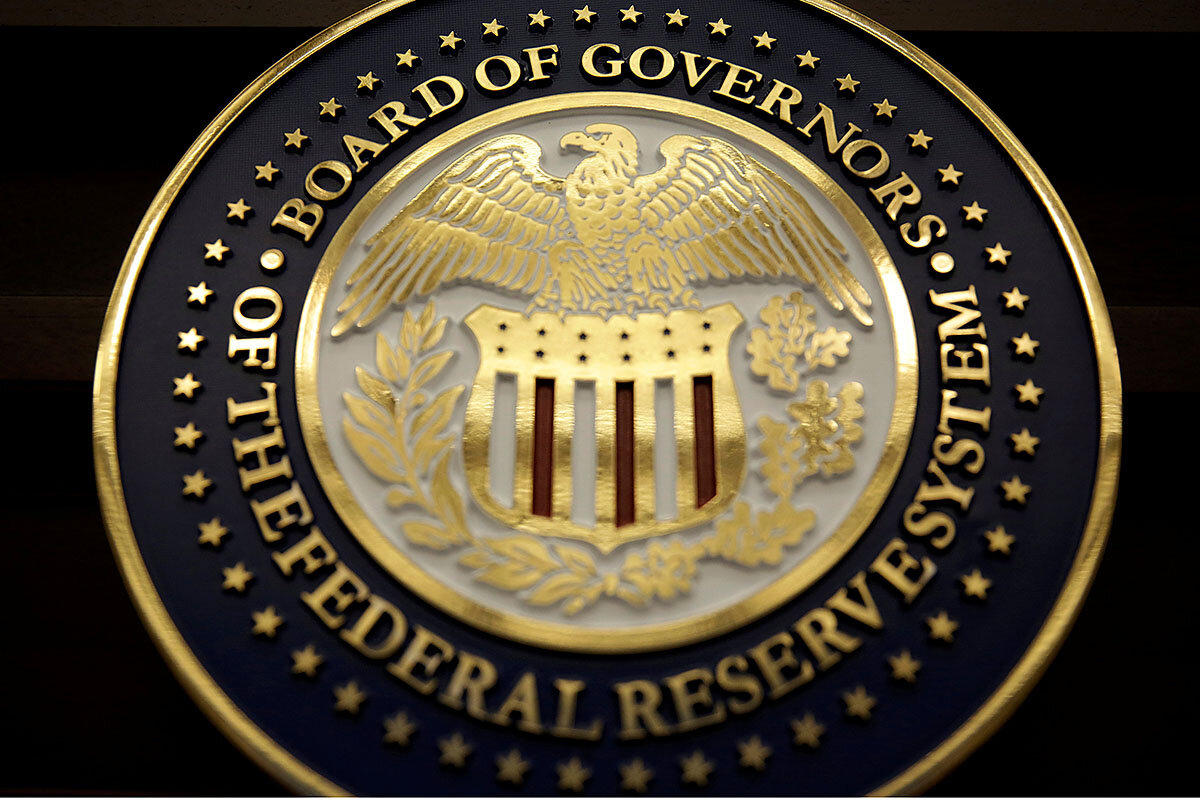
The Great Recession is over. More people are working than ever before. Unemployment is back to pre-recession lows. Average housing prices are at record highs. So is the stock market.
On Wednesday, the Federal Reserve announced it, too, was moving on, preparing finally to whittle away its huge $4.5 trillion portfolio of bonds that it bought to stimulate the economy. Although other anti-recession policies remain, Wednesday’s move puts the Fed on its final staircase in a return to normal.
But normal isn’t what it used to be. Economists foresee dramatically slower growth in the decades ahead because the previous natural drivers of economic growth – an expanding workforce, increasing education, and rising productivity – seem to have largely plateaued. Without economic growth, Americans’ incomes can’t rise.
If the United States is to counter this bleak “new normal,” the Fed can only do so much with its hand on the lever of money supply. Either new technology will have to make workers much more productive, or the federal government will need to embrace a suite of big policies to encourage growth, or both.
“Forty years ago, things also looked bleak,” writes Bret Swanson, president of Entropy Economics LLC, a strategic research firm specializing in technology, innovation, and the global economy. “We had entered what the Club of Rome asserted in its famous 1972 ‘Limits to Growth’ report was a long state of decline.... [But] the United States stood up and chose a bold, new, distinct path across a range of policies, unleashing waves of growth and technology not only in America but across the globe.”
Can the US do it again?
The slowdown is unmistakable. Of the 11 post-recession recoveries since 1950, the current one has been the slowest, with the economy growing at 2.1 percent a year, half the rate or less of the rebounds before the 1990s.
And growth has been uneven. While average home prices are now above the highs before the recession, most of the gains have been in booming metros, while two-thirds of US homes have not fully recovered, real estate website Trulia reported in May. Income inequality remains worse than before the recession.
Going forward, growth will be even slower, many economists warn. “GDP growth is likely to be well below historical norms, plausibly in the range of 1-1/2 to 1-3/4 percent per year,” John Fernald, a senior research adviser at the Federal Reserve Bank of San Francisco, concluded in an article last October.
There are two main factors behind the slowdown: 1) the workforce is no longer growing rapidly, due to baby boomer retirements, and 2) The educational gains of the workforce have for now plateaued. In the past, college graduates took over from retirees who had high school degrees; now, college graduates are more frequently replacing college graduates.
The productivity puzzle
A third driver of economic growth is technology. In the past, breakthrough innovations routinely made workers more productive – think steam engines, electric lighting, interstate highways, and so on. Between 1947 and 1973, productivity growth averaged 2.1 percent a year, points out Northwestern University economist Robert Gordon.
Then, from 1973 to 1995 it slowed to an anemic 0.5 percent per year. (Overall, the economy grew faster because the workforce was expanding with the influx of women into the working world.) Productivity growth surged again to 2.0 percent from 1995 and 2004 as the PC replaced adding machines, file cabinets, and mainframe computers.
But since then, productivity growth has fallen back inexplicably to 0.5 percent per year. The result is an economy that’s $3 trillion smaller than it would have been if the 1995-2004 growth rate had continued.
Economists are puzzled. The internet, smartphone, cloud, artificial intelligence, and other technologies have transformed jobs and disrupted industries, but apparently they have done next to nothing to boost productivity.
The slowdown is evident in nations around the world. That they’re taking shape in the world’s largest economy, which is at the cutting edge of many of those technologies, is sobering.
One possibility is that the benefits of the digital revolution are merely delayed.
In the meantime, many experts are pushing for policy changes to deliver more growth. Those policies may become especially important as the Federal Reserve slowly removes economic stimulus by trimming its portfolio, mostly made up of US Treasury and mortgage-related securities.
On Wednesday, Fed Chair Janet Yellen announced that instead of renewing those securities, the central bank next month would begin to allow them to expire at a rate of about $10 billion a month. That means private sellers would have to step in, and might require higher interest rates as a lure.
Higher rates, in turn, could slow the economy, discourage hiring, and spook stock and especially bond markets. The Fed figures that its portfolio unwinding will be gradual enough so the disruption is minimal.
How to revive growth?
The most obvious way to spur growth may be to cut taxes, although the benefits could be offset if the result is a higher national debt.
Economic studies consistently conclude that higher corporate taxes cause companies to spend less on capital and labor, which means workers are less productive. Republicans in Congress are hard at work on a plan to reduce corporate taxes.
“Tax reform that simplified the corporate tax code and lowered the tax rate would encourage investment,” Brookings Institution economist Martin Baily writes in an e-mail. “In the longer run, policies to provide better training for workers and sustain the funding for science and technology are helpful.”
Worker training has more bipartisan support, although Congress will struggle to find a way to pay for expanding such programs.
Some experts, such as Dutch economist Servaas Storm, point to inequality as a root cause of America’s stagnation. Companies hire low-wage workers rather than buying new equipment that would make those workers more productive, he argues.
Even if growth policies were enacted, the extent of their impact is unclear.
“It is very hard for policy to move the needle on productivity,” Mr. Baily says. President “Trump’s best hope is that he gets lucky and the economy generates faster growth through technology breakthroughs, just as happened in the 1990s.”

In Russia’s Facebook reach, hints of darker intrusions
What role did Facebook play in Russian interference in the 2016 elections? Special counsel Robert Mueller’s team makes the social network a focus of its probe, investigating how social media was used to disseminate foreign propaganda and divisive fake news.

- Quick Read
- Deep Read ( 5 Min. )
In the context of the 2016 presidential election, $100,000 in political ads isn’t much. US political parties and candidates spent tens of millions of dollars to sway voters one way or another. But $100,000 in political ads purchased by a shadowy Kremlin-linked “troll farm” on Facebook – that’s something important. In one sense, this purchase, disclosed by Facebook early this month, represents a new frontier in Moscow’s historic propaganda efforts. Gone are clunky attempts to push the glories of communism and evils of capitalism. In their place are subtler attempts to emphasize existing social divisions in the United States, or sow entirely fake stories – a modern information war that Russia handles with “finesse,” according to one historian. But the real worry among experts is that the ad buy, and others likely similar to it, are simply a small part of a larger effort. One compares the $100,000 purchase to the Watergate break-in – a petty crime whose real importance was rooted in the vast conspiracy of which it was a part.
In Russia’s Facebook reach, hints of darker intrusions

Yes, a shadowy Russian firm with ties to the Kremlin bought about $100,000 worth of Facebook ads intended to sway voters during last year’s presidential campaign, the social media giant disclosed earlier this month.
Does it matter? Given the tens of millions spent on political ads in 2016 that’s a bucket of water thrown down a storm drain. And influencing elections with ads is a delicate science. It requires coordination, timing, and finesse – three things the Russian ad buy doesn’t seem to have had.
The problem is, those Russian-bought online spots might be just a hint of a darker, undetected flood of attempts at influence, according to experts in political communication. To use a different analogy they might be the equivalent of the Watergate break-in. That was a petty crime that by itself didn’t sway the 1972 election. Its real importance was rooted in the vast, illegal conspiracy of which it was a symbol and product.
Thus despite the small size of the Russian Facebook ad buy, “it’s really important to American politics,” says David Karpf, an associate professor in George Washington University’s School of Media and Public Affairs, making the comparison with Watergate.
Facebook revealed the ad buy in question in a blog post from its chief security officer, Alex Stamos, on September 6. Congressional investigators had been pressuring the firm to look more closely at the possible relationship between its online ads and what US intelligence concludes was a Russian attempt to interfere in the 2016 vote.
Between June 2015 and May 2017, 470 “inauthentic” accounts and pages associated with each other and likely operated out of Russia bought about 3,000 ads, wrote Mr. Stamos. About one-quarter of the ads were targeted to a specific geographical area.
Most of the ads did not directly mention a candidate or the election. Instead, they focused on amplifying divisive social and political messages, concluded Facebook.
A common approach
That’s now a common Kremlin approach. Consider Facebook’s smaller rival Twitter. On Sept. 19, the top trending topic from accounts and bots linked to Russia was “Manafort,” according to the Alliance for Securing Democracy, a transatlantic initiative that monitors their activity. That’s almost certainly a reference to Paul Manafort, the former Trump campaign manager now in deep legal trouble for alleged connections to Russian figures. The third trending topic was “Pelosi” – House minority leader Nancy Pelosi (D) of California, a lawmaker heartily disliked by many conservatives.
In one sense, Russia’s social media efforts are a new frontier in Moscow’s historic propaganda efforts. The Kremlin has long used disinformation to manipulate its own citizens while attempting to sow fear, mistrust, and even envy among westerners.
The problem with the old efforts was that they were tied to a political system which had to be defended. This often rendered them clunky, unbelievable, and flat uninteresting. “Soviet Life,” a glossy magazine targeted for readers in the US and Western Europe, featured such gripping articles as “Uzbekistan: Sixty Years of Progress,” and “Bad Day for a Wild Boar.”
In the old days the Soviet Union was limited by ideology and the party line, as well as the grip of bureaucracy, which insisted on multiple approvals for every little item. Propaganda was expensive, and money was tight.
“Under Stalin in particular, people were simply afraid to approve anything interesting, innovative, different, so they often did not,” writes Patryk Babiracki, a historian at the University of Texas-Arlington and fellow at the Berlin Center for Cold War Studies, in an email.
Now those constraints are all gone, according to Dr. Babiracki, author of “Soviet Soft Power in Poland: Culture and the Making of Stalin’s New Empire, 1943-1957.” Meanwhile, Russian leader Vladimir Putin has recognized that escalating and transforming the old propaganda effort is central to his effort to push back against Western dominance. Kremlin-funded outlets such as TV network RT explicitly model themselves on slick Western counterparts. The internet and social media have opened up vast new territory, with automated bots, paid trolls, and military hackers combining to push the Russian line.
This info war is carried out with “finesse,” says Babiracki. Russian-linked accounts repeat false stories, question credible evidence, and amplify any actual news they wish to spread, about intolerance, ideological divisions, terrorism, and natural catastrophes.
“This is all stuff that happens, of course, but the Kremlin wants Western readers to feel that this might be defining of the world in which they live in order to undermine their confidence in the liberal-democratic order,” according to Babiracki.
Part of a larger plan
Given this context, the revelations about the Facebook purchase may seem like a brief glimpse through a door at a larger world beyond.
By itself, the $100,000 ad buy certainly didn’t swing the election. That’s chump change for one thing – the Hillary Clinton campaign alone spent $30 million on digital ads in the campaign’s final months. President Trump’s campaign team focused much of their ad spending online, running 40,000 to 50,000 variants of ads every day to see how tweaks, such as the addition or elimination of subtitles, affected performance.
Plus, as political scientists will tell you, ads don’t work. They are limited in their power to swing voters from one side to another. Their effect wears off quickly. Bunching them is the best policy. They can be effective at giving a little push to voters already leaning one way or another.
What matters is that the $100,000 did not come from nowhere, according to George Washington University’s David Karpf, author of “Analytic Activism: Digital Listening and the New Political Strategy.” Maybe the Kremlin was just experimenting or trying to mess with candidates’ heads. More likely the money was part of something larger – larger purchases that have yet to be fully detected, or even, as critics charge, part of a larger data effort that might even have been coordinated with data targeting officials linked to the Trump campaign.
There is no public evidence of such linkage. However, special counsel Robert Mueller has served Facebook with a search warrant to gather information on the accounts linked to the Russian spending, according to CNN and The Wall Street Journal. Mr. Mueller appears to be trying to piece together as large a picture as possible of Russia’s clandestine information effort, and any possible links with US persons.
Some members of Congress believe Facebook has not been entirely forthcoming with them, and are threatening to call chief executive officer Mark Zuckerberg to testify at hearings, perhaps with an eye to further regulations or legislation that would force the firm to be more transparent about its effect on politics.
But for Facebook the immediate worry is probably Mueller, not televised hearings.
“The question I have is how well is Facebook cooperating with Mueller,” says Dr. Karpf. “If they are cooperating fully with Mueller, it probably signals they get it.”

Chechnya’s hard turn to political Islam rattles Kremlin
The Kremlin is clear on the following point: When it comes to the law in Russia, what it says goes. But Chechnya's leader, who was put in place by Vladimir Putin, increasingly is refusing to stay inside the lines drawn by Moscow.

- Quick Read
- Deep Read ( 4 Min. )
Ramzan Kadyrov, the Chechen strongman, has always been one of the most, if not the most, noteworthy of Russia's regional leaders, though often for less than positive reasons. But he recently made waves even beyond his norm by staging a demonstration of at least half a million people in downtown Grozny, the capital of Chechnya, earlier this month to express solidarity with the persecuted Rohingya Muslims of Myanmar (Burma) and demand the Kremlin take action to protect them. Russia supports the Myanmar government – and leaders of Russian regions do not, as a rule, question Russian foreign policies. But President Kadyrov, who appears to be trying to promote himself as a global player among Muslims, has also been imposing sharia (Islamic law) in Chechnya, in defiance of Russia’s secular Constitution. And that does not sit well with the Kremlin. “Putin clearly does not like it,” says Alexei Malashenko, an Islam expert with the Moscow Carnegie Center.
Chechnya’s hard turn to political Islam rattles Kremlin
Russia fought two bloody wars in its Caucasus republic of Chechnya, ostensibly to crush an emerging threat of Islamist extremism on its own soil.
So it is with no small irony that the strongman Moscow installed to run a pacified Chechnya, Ramzan Kadyrov, is increasingly posing a similar challenge to Russia's secular constitutional order. Mr. Kadyrov is imposing sharia (Islamic law) on his population – and lately, even defying the Kremlin's foreign policy – with an apparent eye on a global, Islamic stage.
“Kadyrov wants to be considered a leader among world Muslims. His ambitions are very high,” says Alexei Malashenko, an Islam expert with the Moscow Carnegie Center. “He has introduced politicized Islam in Chechnya, and this is definitely a problem for the Kremlin. [President Vladimir] Putin clearly does not like it.”
Kadyrov has always been one of the most, if not the most, noteworthy of Russia's regional leaders, though often for less than positive reasons.
Sometimes his antics look simply baffling to outsiders, as when he recently ordered almost 1,000 divorced Chechen couples to reunite “for the sake of the children,” his ongoing efforts to force Chechen women to adhere to a “Muslim dress code,” or his endorsement of polygamy in Chechnya – which is strictly against Russian law.
At other times even Russian social conservatives look on with horror, as when dozens of gay Chechen men were rounded up earlier this year, beaten, tortured and an unknown number killed. The frustration of Russian security services with Kadyrov over his consistent refusal to permit Moscow-based police to operate in the republic, sometimes punctuated by death threats, is an open secret.
But the wayward Chechen leader launched an open challenge to the Kremlin – and signaled his own widening ambitions – by staging a demonstration of at least half a million people in downtown Grozny earlier this month to express solidarity with the persecuted Rohingya Muslims of Myanmar and demand the Kremlin take action to protect them.
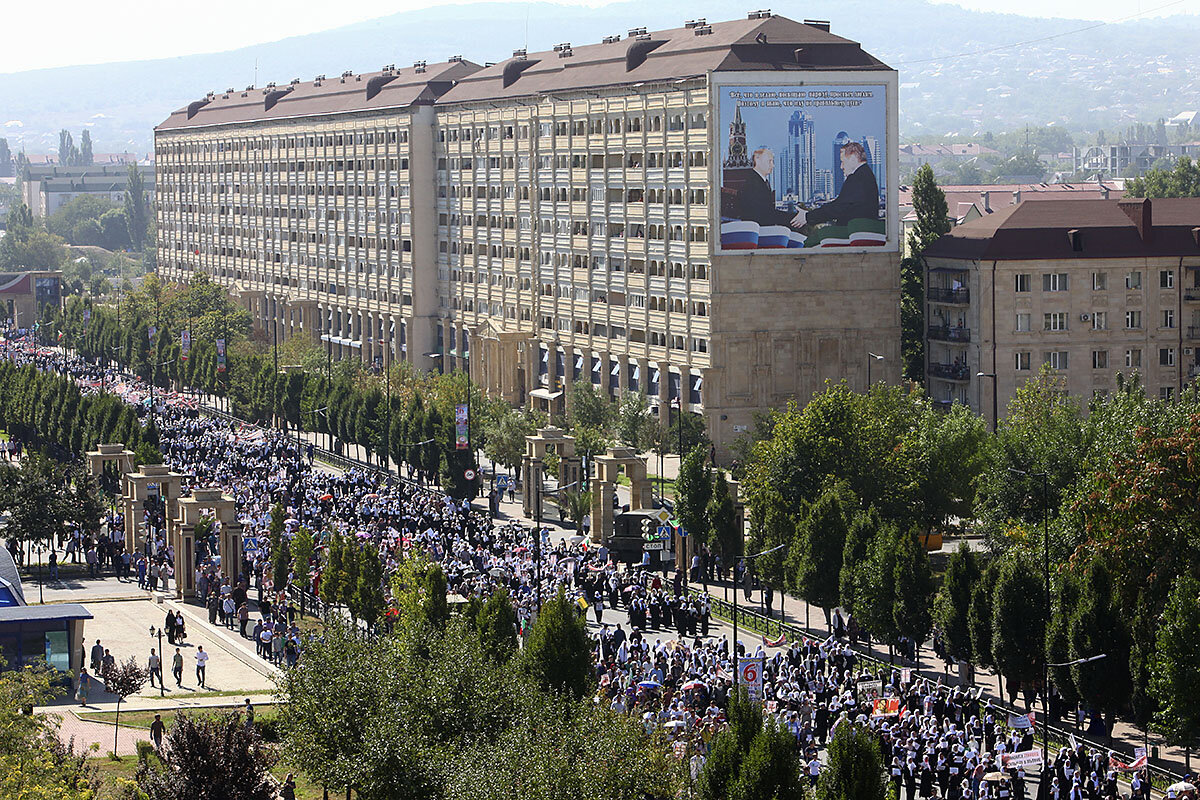
Russia, along with China, supports the Myanmar government, and has largely evaded addressing the plight of the Rohingya. Leaders of Russian regions do not, as a rule, question Russian foreign policies. Asked about it later, a visibly annoyed Vladimir Putin merely said that “each person is entitled to having one’s own attitude regardless of rank or position.” But subsequently, police in Moscow violently suppressed a pro-Rohingya rally by local Muslims in front of the Myanmar embassy, arresting 17 people – all reportedly Chechens.
'A very special place inside Russia'
Kadyrov has been actively reshaping the local strain of Islam – Chechens are traditionally Sufi Muslims – and turning it into a political tool to enhance his own power and posture as an Islamic champion on the world stage.
“Kadyrov has de facto imposed sharia law on Chechen society. It's now an Islamicized region of Russia, the only one,” says Rais Suleymanov, an Islamic expert at the security services-linked Institute of National Strategy in Kazan. “Women must wear hijabs, men wear beards, including officials. Religion has become part of the political system of Chechnya. Imams have the status of peoples' deputies, indeed they are effectively civil servants. Nothing like this happens anywhere else in Russia.”
Another majority Muslim region of Russia that once tried to declare independence from Moscow, the Volga republic of Tatarstan, has managed to expunge Wahhabi influences while obeying Russian law and maintaining the open, multi-ethnic character of its society. Tatarstan has since become a relative economic powerhouse, and is approvingly cited by officials in Moscow as a showplace for the kind of secular and tolerant Russia they want to build.
Yet Kadyrov's political challenge could make waves even in Tatarstan.
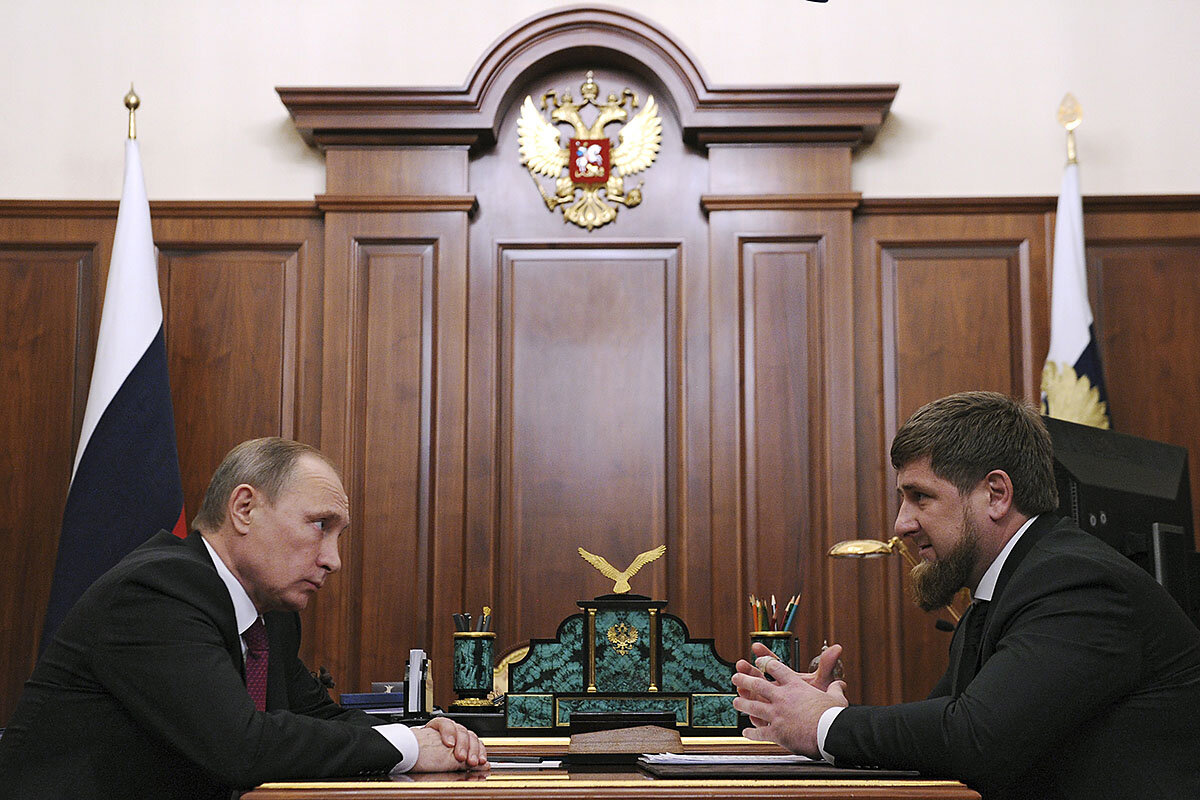
“The head of Tatar Muslims, Mufti Kamil Samigullin, supported Ramzan Kadyrov's position on what's happening in Myanmar,” says Andrei Bolshakov, an expert on conflict studies at Kazan University. “There have been words of support from many religious leaders here. Islam is a united religion and a Muslim, wherever he lives in Russia, is a Muslim.”
The conundrum for the Kremlin is that Kadyrov has pacified Chechnya and sidelined the internationally backed Islamist extremist forces that in past years carried out dozens of terrorist attacks in major Russian cities. And Kadyrov seldom misses an opportunity to express his total loyalty to Putin personally.
“Putin considers Kadyrov to be a pillar of Russian control in the Caucasus,” says Mr. Malashenko. “Kadyrov has made so many enemies in Chechnya that, without Putin's backing, he probably would not last. So, they need each other.”
But the strains are growing, he says.
“Chechnya has become a very special place inside Russia. Kadyrov uses Islam as a tool of social and political management. And he does seem to have the enthusiastic support of young Chechen men, who totally embrace this Islamization.
“But most of society probably does not care for it. There are many indications that women, in particular, are becoming weary of the burdens it places on them, the headscarves, forced subordination to husband, and so on. Most Chechens grew up in secular conditions, they are aware that life goes on more normally in the rest of Russia, and they want something different.”

Can games teach empathy? A look at the shortcomings.
In an era of digitally reinforced narcissism, can video games promote empathy rather than dull it? So-called empathy games can be a beginning point for promoting understanding of marginalized groups, experts say, but they have considerable limitations.

- Quick Read
- Deep Read ( 6 Min. )
In an era marked by ubiquitous technology, the idea of teaching empathy through video games holds a certain appeal. But the creator of one of the first so-called empathy games is not entirely comfortable with the term. Anna Anthropy received acclaim from both the gaming community and from educators for her 2012 game Dys4ia, an interactive and autobiographical depiction of a trans woman’s journey through hormone replacement therapy. Today, Ms. Anthropy balks at the idea that her story could be representative of any collective “trans experience.” It offers a glimpse of how one trans woman views her world, but is unlikely to generate the same level of mutual understanding that comes from actually interacting with people, she maintains. As empathy games become more common in classrooms, conferences, and sensitivity training programs, developers whose work has been unwittingly lumped into the genre caution that empathy is not a singular goal that can be checked off at the end of gameplay. Instead it must be earned through a process of self-examination and emotional labor.
Can games teach empathy? A look at the shortcomings.

“Dys4ia” isn’t your typical video game. There are no bosses to defeat or weapons to soup up. On their face, the challenges are even more simple than the game’s pixelated graphics: Try to squeeze into an ill-fitting shirt; Find an empty stall in the women’s restroom. And unlike most games, “Dys4ia” cannot really be won. That’s because “Dys4ia” is more than a game. It’s an autobiographical depiction of a transgender woman’s journey through hormone replacement therapy.
Since its release in 2012, “Dys4ia” has received critical acclaim for its gameplay, but more so for its politics. Through deeply personal vignettes, it appeared to communicate the unseen struggles of an already underrepresented community. It came to be known as an “empathy game,” because it allowed players to “walk a mile in the shoes” of a trans woman. This was the promise that so many hung on “Dys4ia” and other games like it.
But many creators of so-called empathy games have grown to resent the term. Anna Anthropy, creator of “Dys4ia”, was shocked to find that classrooms and conferences were using her game to teach people “what it’s like to be a trans woman.” For one thing, she never intended for “Dys4ia” to be representative of any collective “trans experience.” It is simply a window into her individual experience. And while it offers a glimpse of how one trans woman views her world, it is unlikely to generate the same level of mutual understanding that comes from actually interacting with people.
“As creators – especially those of us who deal with things like trauma, disability, mental illness or the experience of being a member of a marginalized community – we want to express these things,” says Karl Hohn, a member of the New York-based art and indie game collective Babycastles. “But you start running the risk of emotional tourism when your work is understood as, ‘listen to this song, play this game, go see this play, watch the film and you’ll understand.’ ”
The promise of empathy games
In an era marked by ubiquitous technology, the idea of teaching empathy through video games holds a certain appeal. And there’s considerable precedent for the illustration of other perspectives through play and storytelling.
“Humans learn empathy through interaction and imitation and play,” Mr. Hohn says. “That’s how children learn empathy. And a lot of studies do suggest that immersing yourself in another person’s state of mind is beneficial to empathy.”
Games like “Dys4ia” can offer an intial step toward understanding the experiences of marginalized communities, but the work of developing true empathy needs to be ongoing and should include both active engagement with people from those communties and a certain amount of self-reflection, says Anthropy.
The label “empathy game” gives players implicit permission to excuse themselves from doing the “ongoing, conscious work of addressing their privilege,” Anthropy says. Once players believe they have sufficiently empathized with the subject of the game, they can parachute out of the experience without actually applying that empathy to their lives.
“Empathy games rarely address how a privileged audience is complicit in the suffering they're dipping their toes into,” Anthropy says, “and ultimately the whole process is a congratulatory pat on the back rather than something that leads into actionable behavior.”
Anthropy responded with an art installation called “Empathy Game,” which debuted at Babycastles gallery in 2015. She invited players to strap on a pair of her old boots (fitted with a pedometer) and travel along a winding path. Walking a mile in Anthropy’s shoes, literally, would win you a single point – but that’s all. The game offered some competitive satisfaction, but ultimately taught players nothing about her actual experience. The point, Anthropy says, was to highlight “hollow notions” of empathy and allyship won in a few minutes of gameplay.
The term “empathy game,” by design, treats empathy as a goal to be achieved. So when a player completes the game, the subtext is that they have suddenly “become empathetic” to the experience of a person or group. But empathy is a process of ongoing education and self-reflection, Hohn suggests, not just a state of being.
“I think, at best, these games could open the door for you to start the self-examination and emotional labor that is required to achieve empathy,” he adds.
Virtual voyeurism?
In recent years, virtual reality has emerged as the latest vehicle for empathy-driven storytelling. When director Chris Milk brought his “Clouds Over Sidra” to the United Nations in 2015, the virtual reality documentary, which follows a young Syrian girl in a refugee camp, opened to praise. Sidra’s plight, it seemed, was especially poignant in 360 degrees.
The following year, UNESCO published a report claiming that digital games could support peace education and conflict resolution. Mr. Milk, in a TED Talk that has since garnered over a million views online, called VR headsets “empathy machines.
But critics question the impact of such machines, and who actually benefits from them.
Robert Yang, a game developer and assistant professor at New York University’s Game Center, is skeptical that the “refugee simulators” popularized by Milk can express profound suffering and difficult political situations in a five-minute run time. Moreover, he argues that VR films simply can’t replace the most powerful type of empathy, the kind you get from talking face-to-face with a real person.
“There’s a weird voyeurism involved,” Mr. Yang says. “Supposedly you’re there when you put on these VR headsets, but you’re not really there. You’re no one. No one acknowledges you [in the virtual space]. There is no relationship there, and I think it’s really hard to develop empathy when there’s no relationship.”
Yang says part of the problem might be how new the technology is; that people are so dazzled by the spectacle of VR that they don’t stop to think critically about it. And when the goggles come off, that momentary reaction of empathy ends.
“Immersion comes from world building and character development,” says Hohn of Babycastles. “We are so invested in the idea that digital technology can help our empathy, that we’re losing track of how older forms really succeeded there.”
Taking a page from literature
That’s not to say that VR can’t embody “better” empathy. Subtlety, Hohn says, is one lesson that interactive storytellers could learn from novels and plays.
“You need to sort of bake the empathy in without putting it right on the front,” Hohn says. Literature and theater do this by highlighting the struggles of marginalized groups through nuanced character development, rather than taking an instructional tone.
“[Empathy machines] almost sound like emotional edutainment games,” he says. “It’s like ‘Reader Rabbit’ for how to feel. And most edutainment games aren’t very good at being a game, and they aren’t very good at education. The ones that are successful are the ones where the educational goal is secondary to the gameplay and the narrative and the world that’s been built for the game.”
A better empathy machine might also support complexity. Social and political realities are often messy and morally ambiguous. By asking players to navigate those complexities, interactive storytellers may be able to evoke a more lasting empathy.
“1979 Revolution: Black Friday” is often characterized as an empathy game, though its creators would argue there’s more to it. The game follows Reza, a young photojournalist who returns to Iran amid revolution, and whose choices inform a number of possible endings. Players are encouraged to consider how their own agency relates to other people and events. Empathy, says executive producer Vassiliki Khonsari, is at the core of the experience.
“I think if we did have an overarching message, the message was to complicate history,” Ms. Khonsari says. “The message was to show how good people end up doing bad things, and how bad people end up doing possibly good things. Once you start unpacking that and becoming cognizant of the consequences of your agency and the decisions you make, you can see how those are really the threads that have created the fabric of history....”
Interactive art can communicate powerful messages, Khonsari says, as long they ask us to reflect dynamically on our values, morals, and interactions with the world.
“What’s unique about video games is [what] they ask of you,” Khonsari remarks. “You have to be an active participant. Through that interactivity, you are giving of yourself and creating a sort of emotional and cognitive investment in the consequences of your actions. That allows you to exercise empathy, because you’re trying to understand what that position is and what the consequences of that position are.”
Other headline stories we’re watching
(Get live updates throughout the day.)The Monitor's View
Lessons in identity from Kurds and Catalans
- Quick Read
- Deep Read ( 3 Min. )
-
By The Monitor's Editorial Board
Coming votes for independence in Kurdish Iraq and Spain’s Catalonia represent a challenge of shifting identity in the 21st century. The votes echo demands by several countries for more sovereignty to protest the perceived effects of global or regional institutions set up to impinge on national sovereignty. (Britain, for example, is negotiating an exit from the European Union. Turkey is pulling away from NATO and Europe.) In Kurdish Iraq and Catalonia there is little assurance that a new independent entity would be better governed. Internal political squabbles in both places could be as intense as those with the mother countries. People will always seek to define a “we” that helps them find unity under a protective government. The coming votes in Kurdish Iraq and Catalonia might provide lessons on the best way to find that social harmony. The best “self” for any people is to choose peace and harmony with one’s neighbors.
Lessons in identity from Kurds and Catalans
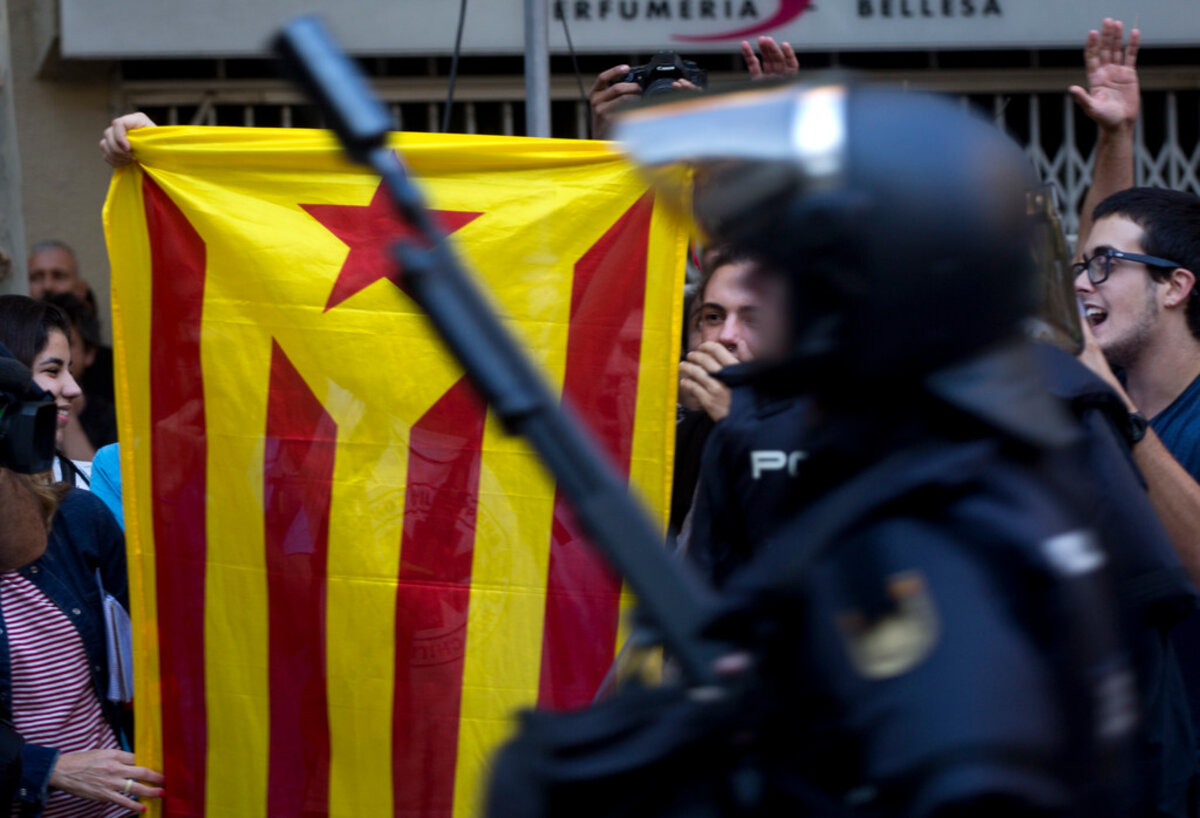
One of the defining challenges in the 21st century has been how to balance demands for independence by certain peoples with the sanctity of national borders. Just in the coming days alone, two regions with distinct identities, Catalonia in Spain and the Kurdish area in Iraq, plan to stage referendums on independence. The outcomes are uncertain, especially in whether they can keep the peace. Yet they may help set a measure of the meaning of “self” in that 20th-century notion of self-determination.
The two votes are an echo of demands by several countries for more sovereignty to protest the perceived effects of global or regional institutions that were set up to purposely impinge on national sovereignty. Britain, for example, is now negotiating an exit from the European Union. On Tuesday, President Trump spoke at the United Nations about taking back American sovereignty from international bodies that the United States set up. Turkey, meanwhile, is pulling away from its ties with NATO and Europe.
The idea of the nation-state is only a few hundred years old, born out of Europe’s religious wars that resulted in a need for secular rule within set geographic boundaries. Nation-states are a step up from being ruled by a dynasty, clan, cleric, or tribe. For many people in the past two centuries, the formation of a nation-state was a way to escape a colonial empire.
The biggest issue in starting a new state is whether it can be done without violence. The Islamic State group killed thousands in attempting to form a caliphate in parts of Iraq and Syria. South Sudan was split off from Sudan in 2011 and has not seen peace since. Kosovo was forcibly split from Serbia and declared independence in 2008, but Serbia still has not made peace. Russia took Crimea by force in 2014 after Ukraine moved to join the EU and remove itself from Moscow’s orbit.
Yet East Timor did separate with relative peace from Indonesia in 2002. And Britain allowed Scotland to vote on separation in 2014, a tolerance that may have led the Scots to vote against leaving.
In many of these cases, people were redefining the object of their collective love. Is it a shared ethnicity, history, language, religion, or geography? Is it to escape historical discrimination and violence? Or do they see unity in higher ideals, such as equality and democratic governance?
For ethnic Kurds in Iraq, the issue is mainly a historical desire for homeland denied them after World War I when European powers divided up the Middle East. But they also now feel like third-class citizens in Iraq, deprived of an equitable sharing of power and resources. Catalonia feels it is culturally distinct from the rest of Spain and that it has not been given its due in the economy.
In both places, however, there is little assurance a new independent entity would be better governed. Internal political squabbles in both places could be as intense as those with the mother countries.
Nation-states still serve a peaceful purpose but they are challenged by shifting identities. Global technologies, such as smartphones and social media, bind people across borders, blurring old identities of race, ethnicity, or religion. More people demand basic rights and inclusive governance, which are universal in their appeal. Often such higher aspirations help prevent a national divorce. They set an identity that embraces diversity rather than one that fears it.
People will always seek to define a “we” that helps them find unity under a protective government. The coming votes in Kurdish Iraq and Catalonia might provide lessons on the best way to find that social harmony. The best “self” for any people is to choose peace and harmony with one’s neighbors.

A Christian Science Perspective
Each weekday, the Monitor includes one clearly labeled religious article offering spiritual insight on contemporary issues, including the news. The publication – in its various forms – is produced for anyone who cares about the progress of the human endeavor around the world and seeks news reported with compassion, intelligence, and an essentially constructive lens. For many, that caring has religious roots. For many, it does not. The Monitor has always embraced both audiences. The Monitor is owned by a church – The First Church of Christ, Scientist, in Boston – whose founder was concerned with both the state of the world and the quality of available news.
Yielding that opens the way for healing
- Quick Read
- Deep Read ( 3 Min. )
-
By Ingrid Peschke
When we get to a yield sign, we must slow down our vehicles, and sometimes be very patient before moving forward. Contributor Ingrid Peschke has found this to be a helpful metaphor for prayer. When conflicting views arise, willfulness tends to push us one way or another. But when we pause and let God, divine Mind, guide us, it allows inspiration to come that brings peace and healing. “When we wait patiently on God and seek Truth righteously, He directs our path,” wrote Monitor founder Mary Baker Eddy (“Science and Health with Key to the Scriptures,” p. 254).
Yielding that opens the way for healing
Yield signs on the road require drivers to slow down and look both ways. Sometimes, the traffic is clear and you can get moving right away. Other times, you have to be very patient and wait until the way opens up.
This simple traffic lesson can be a metaphor for prayer. I’ve found that when challenges arise, turning to God for answers often requires patient listening for and yielding to the ideas that come from divine inspiration. Sometimes it’s tempting to hit the gas and move full speed ahead with a personal agenda, but the yield sign is a reminder to be patient and pause instead.
I’ve learned that this process of yielding is about cultivating a willingness to listen to God, and then to allow the peace and love of God to fill our hearts and mind. Then, feeling God’s closeness and care, we can let the intelligence of divine Mind guide us. This scriptural benediction sums up this kind of prayer: “And the Lord direct your hearts into the love of God, and into the patient waiting for Christ” (II Thessalonians 3:5). The passage reminds me that we all have an inherent love for God, for what is good and right, and we can let that direct our every move. And it is the Christ, the healing presence of God’s goodness, that inspires tender, loving care for our neighbor; that blesses our way, even when there seems to be conflict brewing.
I recently experienced the power of prayerful yielding in a modest but meaningful way when I found myself caught in the middle of conflicting opinions about an important decision that needed to be taken by a group of people who would be meeting for the first time. While en route to meet the others involved, I received an agitated message from one of the parties that seemed to come out of the blue. As the situation grew more unfriendly, I began to doubt whether our meeting could be harmonious, and I, too, began to feel agitated.
Wanting to feel at peace before responding, I went to God in prayer. One of my favorite passages in the Bible provides wise counsel: “Trust in the Lord with all your heart, and lean not on your own understanding; In all your ways acknowledge Him, and He shall direct your paths” (Proverbs 3:5, 6, New King James Version).
I actively affirmed that nothing could interrupt God’s harmony, which includes a joy that embraces all. As I prayed, my thoughts turned to what would help this individual feel most loved and understood in this situation. Rather than resenting her words, I prayed to feel something of the same love for her that God, our divine Parent, has for all of us.
An answer soon came that prompted me to offer a solution that was in my new acquaintance’s favor before we’d even met to discuss the issue. The situation turned around completely. What looked like a sacrifice on my part ended up bringing a sweet atmosphere of mutual affection that I would never have traded. I felt a deep sense of the healing Christ as the first seeds of friendship were planted that weekend.
Though only a few were involved in this particular situation, it has inspired my prayers for harmony in my broader community and the world. How grateful I am that, as Monitor founder Mary Baker Eddy puts it, “When we wait patiently on God and seek Truth righteously, He directs our path” (“Science and Health with Key to the Scriptures,” p. 254).

A message of love
Ready for their referendum
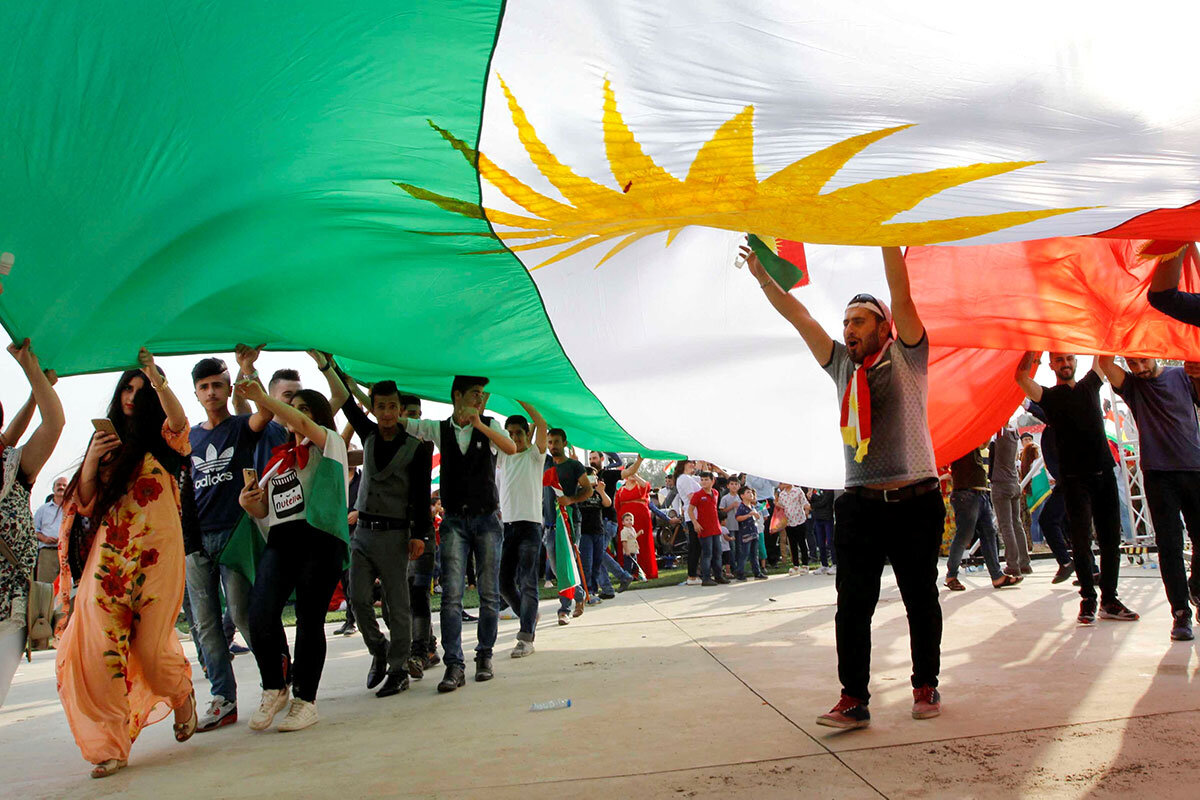
A look ahead
Thanks so much for joining us. Come back tomorrow. We're working on a story about children traumatized by ISIS, who have seen and done things they never should have. If enough teachers can be found, schools can help put them on a path to healing.
As a final treat, here's a link to a cover story we ran about "The Dog Rescuer," who drives thousands of miles to bring shelter dogs from kill shelters in the South to the Northeast so they can be adopted.


